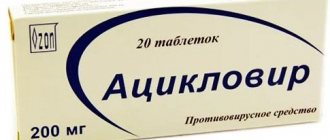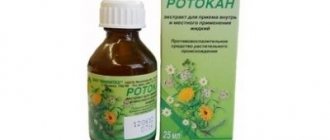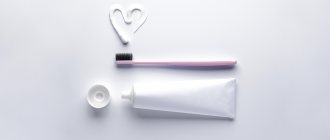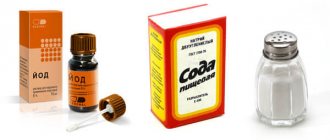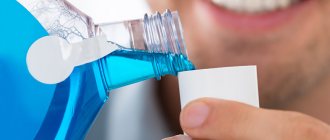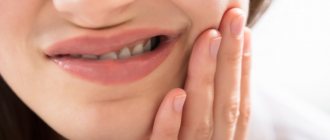Antibacterial compounds play an important role in maintaining oral hygiene. They are necessary to destroy bacteria and reduce pain. A solution of soda, salt and iodine is by far the safest and most affordable means of preventing many dental diseases. Rinsing helps to cope with aching, acute pain, and in some cases even relieve swelling near the gum pocket.
Sodium bicarbonate has many positive properties. Its use prevents the development of carious manifestations and inhibits pathological processes. You can even remove tartar using baking soda powder. Quite often they rinse their mouth with soda after resection of an element of the dentition has been performed or nerve endings have been painfully removed. Antibacterial compounds accelerate the regeneration of soft tissues and have a disinfecting effect.
Treatment of gums with salt
Causes of gum inflammation
Why salt helps
How to properly rinse your mouth with saline solution
Salt gum massage
Other methods for treating gums at home
Bleeding gums, increased sensitivity and bad breath indicate that your gums are not healthy. Why do they become inflamed? Is it necessary to see a doctor or can they be strengthened at home? How to use salt to relieve inflammation? Read more in the article.
How to rinse your nose correctly?
Many people are hesitant to try the procedure on themselves, mistakenly believing that this manipulation is very complicated. At first, it may not be entirely comfortable, but after several sessions, you will get used to it and will cope with it with ease.
There are several ways to rinse the nasal cavity. Let's look at the most common ones:
- The easiest way is using an ordinary pipette: you need to take a few drops of the solution into the pipette and drop it into each nasal passage one by one, tilting your head back. Hold your head like this for a few seconds, then blow out the contents of your nose. This manipulation must be repeated several times. You will immediately feel how much easier it is to breathe.
- Another method involves using a small kettle as a rinsing device. Pour the solution into the kettle and tilt your head to the side, place the spout of the kettle in your nostril and carefully pour the liquid into it. According to the principle of communicating vessels, liquid will flow out of the second nostril. Then repeat the same procedure, but on the other side. During the procedure you need to breathe through your mouth. If you don’t have a suitable kettle at hand, you can use a syringe or syringe without a needle.
- Another well-known method is to pour the washing liquid into a saucer and draw it in with your nose, but do not swallow. Spit out the liquid and repeat the procedure.
Causes of gum inflammation
Gum inflammation can occur for various reasons. Heredity, poor environment, bad habits, hormonal imbalance, etc. But most often, the inflammatory process in the gums occurs due to poor oral hygiene. The more plaque and soft deposits on the teeth, the higher the risk of inflammation. To prevent diseases of teeth and gums, professional hygiene is recommended, which must be done every six months (more often if necessary). The procedure removes deposits that the toothbrush did not reach, freshens breath and makes teeth noticeably whiter.
By the way, scientists conducted an interesting experiment. People who maintained good hygiene and had no dental problems stopped brushing their teeth within three weeks. The result showed that this time is quite enough for primary inflammation to appear on the gums.
Is it possible to gargle with salt?
Rinse is used for sore throat, runny nose, otitis, various pathologies of the ENT organs: acute and chronic tonsillitis, purulent processes in the tonsils, pharyngitis.
At certain concentrations, the salt solution has different therapeutic effects.
Hypertonic dilution of sodium chloride (osmotic pressure is greater than that in the tissues) relieves swelling, reducing sore throat, has antimicrobial activity, thins thick mucus, pus, and helps restore the draining function of the tonsils.
A saline solution with a salt concentration of 0.9% mechanically cleanses the walls of the pharynx from bacteria, viruses, dead cells, and moisturizes the mucous membrane of the oropharynx1.
To reduce the risk of infection, it is advisable to irrigate the nasal cavity and oropharynx after visiting crowded places or communicating with a sick person.
Up to contents
Why does salt help?
Salt is considered one of the most effective methods for treating periodontal disease. It stimulates the restoration of periodontal tissue and relieves inflammation. The effectiveness of salt is explained by the fact that it has the ability to draw out moisture. Once in the oral cavity, salt “takes” liquid from the inflamed area, thus depriving bacteria and microorganisms of their natural habitat. When treating, it is better to use sea salt, as it is rich in iodine.
Salt rinses
Saline solution is considered one of the most effective methods of treating teeth and gums.
It is often used as a first aid remedy before visiting the dentist. Table 1. Types of salt rinse solutions
| View | Preparation |
| Salt + soda | Suitable for those for whom regular saline solution is not suitable. Mix one teaspoon of baking soda and salt in a glass of water. Can be used after tooth extraction, but carefully so as not to injure the socket. |
| Salt + soda + iodine | 1 tsp salt and soda, 2 - 3 drops of iodine per glass of warm water. |
| Salt + vodka | Add 2 - 3 tbsp to a glass of water. vodka and 1 tsp. salt. Rinse with caution so as not to burn the mucous membrane. |
| Salt + herbal decoctions | Decoction recipes:
|
Gargling with soda
The content of the article:
- What does rinsing do?
- Benefits of soda
- Gargling
- How to gargle
- Precautions when using baking soda
- When to see a doctor
- Conclusion
What does rinsing do?
Gargling is an old and proven method of relieving swelling of the oral mucosa. Swelling can be caused not only by infection, but also by a number of other diseases.
Rinsing will be effective for diseases such as:
- inflammation of the tonsils;
- laryngitis;
- sinusitis;
- allergy;
- vocal strain;
- cough.
You can prepare a rinse solution yourself without a prescription or visiting a doctor. But do not forget about contraindications and precautions when using soda.
Benefits of soda
Sodium bicarbonate (baking soda) is a salt formed by combining sodium hydroxide and carbonic acid. It helps maintain acid-base balance in the body. The chemical formula used for sodium bicarbonate is NaHCO3. This is a whitish powder that first alkalizes water and then completely dissolves in it.
Baking soda is easy to find in any supermarket. One of its advantages is that it is non-toxic when taken orally. Excellent for oral hygiene as it is a practical ingredient for natural teeth whitening and also for making homemade toothpaste. Thanks to its components, soda provides fresh breath, prevents and eliminates tartar, and prevents the occurrence of caries. Is it possible to gargle with a soda solution? Let’s consider further.
Gargling
Yes, baking soda and water are an ideal remedy for a sore throat.
What does gargling do:
- disinfection of the throat and mouth;
- healing of small wounds;
- reduction of swelling;
- elimination of soreness and pain.
By rinsing with a soda solution, an alkaline environment is created in the larynx, which is unfavorable for bacteria. They cannot reproduce, which means inflammation will decrease. Also, rinsing helps to mechanically wash away bacterial plaque and mucus. Finally, soda perfectly softens irritated mucous membranes, as a result, the sore throat goes away.
How to gargle
Gargling is easy. This procedure can be carried out even several times a day, but the safe therapeutic amount during the day is 3-4 rinses, depending on the composition of the rinse.
The finished product (solution or powder) should be dissolved in 1 glass of water. The resulting mixture must be boiled and cooled to avoid future throat irritation. Gargle with the solution for 2-3 minutes. It cannot be swallowed, therefore such manipulation is contraindicated for small children.
Proportions for gargling with soda:
- 1 glass of warm water.
- 1 teaspoon baking soda.
If the solution is intended for a child, then the volume of soda should be reduced by 2 times. You can add 1-2 drops of iodine to these ingredients.
Another option is to add lemon juice to the baking soda solution. Lemon is a fruit with antibacterial properties. Its juice helps clear and disinfect the throat and relieves pain from other conditions such as tonsillitis.
Ingredients:
- 1 teaspoon lemon juice;
- Half a glass of water;
- 1/2 teaspoon baking soda.
Add baking soda and lemon juice to a glass of water and mix thoroughly. Place the mixture in your mouth, gargle for about thirty seconds and spit it out. Repeat this procedure three to five times a day. A mixture of baking soda and lemon relieves throat discomfort and freshens breath.
Many people are interested in whether it is possible to gargle with soda for tonsillitis, when it is accompanied by pus and a feeling of pain. Yes, in this case it will be possible to quickly remove the formed purulent rally fluid and speed up the regeneration of mucus.
Soda solution does not replace antimicrobial drugs and is not a drug in itself. But its advantage is its versatility. Soda is a good antiseptic, and it is hypoallergenic, and therefore suitable for everyone, regardless of age and complexity of the disease. If you have any doubts about this gargling method, consult your doctor.
Precautions when using baking soda
When gargling, keep in mind that baking soda can also cause side effects, especially if a person swallows it.
Side effects of baking soda are unlikely, but it doesn't hurt to be aware of them:
- nausea;
- heartburn;
- flatulence;
- muscle weakness;
- anxiety;
- difficulty breathing.
Therefore, before using the product, it is recommended to consult a doctor who will tell you how to rinse correctly, in what proportions and what precautions should be taken.
Always consider contraindications. For people with heart disease, gargling with soda can be harmful. You should use baking soda rinses with caution for peptic ulcers. Carbon dioxide formed in the stomach causes increased secretion of digestive juices and irritates the receptors of the mucous membranes. And this soon leads to a deterioration in the patient’s condition.
Absolute contraindications to this procedure are as follows:
- individual intolerance to sodium bicarbonate;
- burn of the mucous membrane of the mouth or throat;
- malignant neoplasms in the mouth or throat;
- acute diseases of the stomach and esophagus.
It is not advisable to rinse your throat during early pregnancy, as this can cause a gag reflex. Contraindicated in case of toxicosis, but in later stages of pregnancy this method of treatment can be used. There will be no harm to the health of the baby or the expectant mother, and the benefits will be felt immediately. This is important for pregnant women, since many pharmaceuticals are prohibited during pregnancy.
In overdose, baking soda is also toxic. This is due to the high sodium content of the powder. When someone takes too much sodium bicarbonate, the body tries to correct the salt balance. This causes diarrhea and vomiting.
When to see a doctor
If the pain does not disappear after 3-4 days or other symptoms appear (fever, cough, difficulty breathing, etc.), you should consult a doctor. He will examine the patient, take the necessary tests and select the correct, effective treatment technique.
Rinsing with baking soda may not be enough for recovery. The doctor will prescribe pharmaceutical medications to relieve sore throat and reduce inflammation. These can be antibacterial, antiseptic agents, drugs that relieve pain, swelling, and inflammation.
Conclusion
Gargling with soda is one of the methods of treating it. Often a soda solution is used for this, as it has a high anti-inflammatory and antibacterial effect. This method is accessible and inexpensive and can be used at home without a doctor’s prescription. It has virtually no contraindications; the main thing is to adhere to precautions when handling soda. In the early stages of the disease, the method is effective, but it is a symptomatic method of treatment, so gargling with soda for a sore throat cannot replace full treatment. If after a few days the symptoms of the disease do not disappear, but intensify, it is recommended to consult a doctor for advice.
How to properly rinse your mouth with saline solution
To prepare the solution you need 1 – 2 teaspoons of salt and a glass of boiled water. However, there are a number of subtleties that need to be taken into account.
- Before rinsing, you should brush your teeth.
- The solution should be warm. Hot can burn the mucous membrane, and cold can increase the pain.
- It is recommended to rinse your mouth after every meal.
- After using the saline solution, you do not need to rinse your mouth with water. If there is a need, you should wait at least 5 minutes.
Despite its effectiveness, the salt solution is not an alternative to professional treatment. If you have any problems with your gums, we recommend that you consult a doctor.
Remember that the health of your teeth depends on the condition of your gums, so try not to delay your visit for too long. You can make an appointment with our doctors right now: 220-86-30
What's the benefit?
The use of saline solution has long established itself as an excellent preventive and therapeutic agent that helps prevent the development of airborne diseases. The solution disinfects, cleanses the nasal passages, preventing the further spread of pathogens, and relieves swelling. The procedure itself cannot be called too pleasant, but the therapeutic effect is obvious, the main thing is to carry out the washing itself correctly. This method can be used for nasal congestion in children, as well as for pregnant women.
The main components needed to prepare the solution are salt and water. Ready-made saline solutions based on sea salt can be purchased at any pharmacy, for example, the preparations “Aqualor”, “Aquamaris”, “Dolphin” - all these are convenient and effective devices for carrying out the procedure of sanitation of the nasal cavity at home. But a saline solution with a similar therapeutic effect can be prepared at home.
Other methods for treating gums at home
- Oral baths with decoctions and tinctures, which include Kalanchoe, chamomile, St. John's wort, calendula and other anti-inflammatory herbs and extracts.
- Special diet - just increase the number of foods that contain a large amount of calcium (cheese cheese, cottage cheese, beans, almonds, etc.) and vitamin C (orange, kiwi, strawberries, black currants, etc.).
- To give up smoking. Cigarettes worsen the condition of teeth and gums and provoke the development of inflammation.
Home methods for treating gums bring good results, but they can never replace full-fledged dental treatment.
Properties and benefits of soda for teeth - the principle of action of mouth rinse
Baking soda will help relieve toothache.
Baking soda does not have a negative effect on tooth enamel. A rinsing composition based on it has the following beneficial properties:
- has an antiseptic effect, eliminating pathogenic microorganisms;
- whitens the surface of teeth;
- relieves pain;
- makes breath fresh;
- reduces the severity of the inflammatory process.
Important! A composition with a weak concentration of soda can be used even during the period of teething in infants. To relieve pain, this product is lubricated on the gums and tongue.
Water with soda dissolved in it has a pronounced antiseptic effect and also suppresses pain. This product is non-toxic and safe for teeth and mucous membranes of the oral cavity.
Contraindications
First of all, it is important to take into account that the whitening effect of soda is a consequence of its abrasive effect on the enamel surface, so you should not overuse such cleanings, because this can destroy your teeth. Brush about once a week, and in between brushings, use toothpaste with a high fluoride content - this will help quickly return the enamel to its original condition.
If we are talking about formulations containing both soda and hydrogen peroxide, they cannot be used in the following cases:
- High sensitivity of teeth
- Caries
- Pulpitis
- Gum health problems (periodontal disease, bleeding)
- Naturally thin tooth enamel
- Inflammatory process in the oral cavity
Also, such compositions can cause disturbances in taste perception.
Dentists categorically do not recommend using soda and compounds with it if you wear braces. During this period, any lightening procedures are contraindicated, including traditional medicine methods, as this can lead to the formation of persistent dark spots on the teeth.
FAQ
- Do not rinse your mouth on the first day after wisdom tooth removal!
Is it acceptable to rinse your mouth with baking soda after wisdom tooth removal? After wisdom tooth removal, severe pain may persist for some time. But, even despite this, within 24 hours after the manipulation, the oral cavity cannot be rinsed with any solution, since there is a high risk of washing out the protective blood clot from the socket at the site of the extracted tooth. After the specified period, you can rinse.
- Is it possible to rinse an open tooth? Open tooth is a condition that involves opening the tooth to remove the nerve. In this case, rinses are prescribed to provide an antiseptic effect. It is allowed to use a solution of soda.
- What is better for procedures – saline or soda solution? Both of these solutions are effective, but each of them is suitable for a specific case. Baking soda has a greater antiseptic effect, while salt has a healing effect.
- Why is antiseptic treatment of the oral cavity necessary after tooth extraction? After tooth extraction, the treated area remains vulnerable to various infections until healing. To prevent the development of the inflammatory process, you should rinse your mouth with antiseptic solutions.
- How to make soda baths for teeth? Dental baths are a procedure that is almost no different from rinsing. A distinctive feature is the need to keep the solution in the mouth, between the gum and cheek, for up to 40 seconds. In one session, you need to repeat the manipulation up to 4 times a day.
Composition and beneficial properties
Baking soda is sodium bicarbonate NaHCO3, which is a white powder with small crystals. Sodium bicarbonate is easily soluble in water, due to which it can be used without problems as a means for preparing various solutions for rinsing purposes. This solution has an antiseptic effect, so it can be used to alleviate the patient’s condition with gum inflammation.
This type of packaging can be found in every kitchen!
The reaction of soda with acids formed in the oral cavity and negatively affecting tooth enamel leads to the formation of carbon dioxide and water, which means additional protection of the enamel from destruction. A solution of sodium bicarbonate is also useful for thrush localized in the mouth, since soda creates an alkaline environment in the mouth that is detrimental to the fungus that causes the disease.
